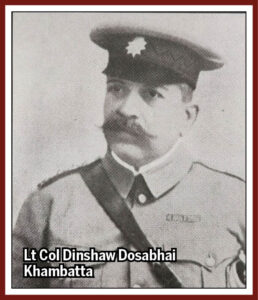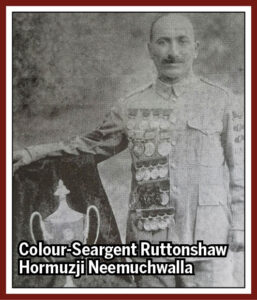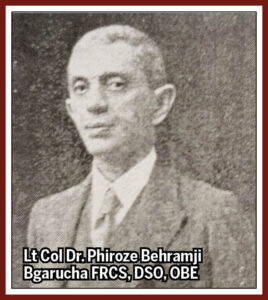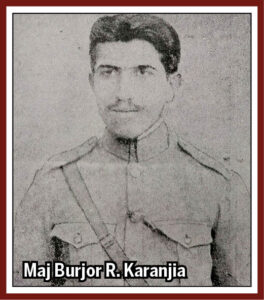Adil J. Govadia
 During the two World Wars, British India had callously sacrificed thousands of Indian soldiers – with nearly 75,000 native Indian soldiers martyred in WW I and over 1.2 lakh in WW II. Despite India’s prodigious contribution in terms of men, material, money and rations, their heroic stories of valour and self-sacrifice sadly remain omitted or consigned to postscripts of the British history. Since mid-19th century, Parsi-Zoroastrians demonstrated enthusiasm to join the Armed Forces, serving meritoriously, notwithstanding the then prevailing racial discrimination practiced by the English. Their outstanding contribution is by far much greater than their statistical strength, a fact that needs to be recognized and treasured.
During the two World Wars, British India had callously sacrificed thousands of Indian soldiers – with nearly 75,000 native Indian soldiers martyred in WW I and over 1.2 lakh in WW II. Despite India’s prodigious contribution in terms of men, material, money and rations, their heroic stories of valour and self-sacrifice sadly remain omitted or consigned to postscripts of the British history. Since mid-19th century, Parsi-Zoroastrians demonstrated enthusiasm to join the Armed Forces, serving meritoriously, notwithstanding the then prevailing racial discrimination practiced by the English. Their outstanding contribution is by far much greater than their statistical strength, a fact that needs to be recognized and treasured.
Parsis readily volunteered their services, facilities and amenities for the country whenever required or when faced with external aggression, even sacrificing their own lives. Given the vastness of the canvas of Parsi-Zoroastrian bravery and distinction, it is impossible to list all achievements of the ever-valiant Parsi men and women who, despite serving with distinction and laying their lives under the British flag, remain unrecognized and uncelebrated till date!
As far back as 1860, long before World War I, when Air and Naval forces weren’t existent, traces of Parsi ‘volunteers’ in the Army’s Medical Services are fleetingly recorded in some Parsi journals. In June 1877, Seth Kharshedji Fardunji Parakh initiated the Parsi Volunteers Corps in Bombay. It was declined by Sir Richard Temple, Governor of Bombay, on the grounds that the regional law did not permit Corps comprising only native Indians. In May 1878, the Poona Parsis petitioned Lord Lytton, Viceroy of India, once again asking permission to raise an exclusively Parsi Corps. It was declined yet again on the grounds that native Indians sufficiently lacked in spoken English (Ref.: ‘The Parsis’ by Mlle. Delphine Menant translated by M M Murzban). In July 1878, Poona’s Seth Kavasji Dorabji applied yet again for admission, which was also turned-down as “…only Europeans can be enrolled.”
Given their eagerness to join the military / para-military services, the Parsi-Zoroastrians later joined the volunteer corps in England and achieved coveted distinction, especially in the usage of fire-arms. But, because in British-India, regulations did not permit separate Corps for Parsis in Poona and Bombay, Parsi-Irani volunteers got scattered amongst several other Indian Corps, primarily ‘The Baluchistan Volunteer Rifles’, ‘The Sind Volunteer Rifles’ and ‘The Allahabad Volunteer Rifles’. In ‘The Baluchistan Volunteer Rifles’, Parsi-Irani volunteers comprised 30 to 35% of the total strength.
 Parsi-Zoroastrians also made noteworthy contributions in the field of nursing and health management services for wounded soldiers. Parsis in India and abroad readily provided accommodation for treating the injured. Prominent were Lady Frenny and Sir Dhunjibhoy Bomanji’s massive estate in Windsor, ‘The Willows’, having its private race course, used as a sickbay for the wounded in World War I. Properties of the Tata group, including the Taj Mahal Hotel in Bombay, were also used to treat the wounded during World Wars I & II. Similarly, the Petit Parsee General Hospital in Bombay, was extensively used during both World Wars.
Parsi-Zoroastrians also made noteworthy contributions in the field of nursing and health management services for wounded soldiers. Parsis in India and abroad readily provided accommodation for treating the injured. Prominent were Lady Frenny and Sir Dhunjibhoy Bomanji’s massive estate in Windsor, ‘The Willows’, having its private race course, used as a sickbay for the wounded in World War I. Properties of the Tata group, including the Taj Mahal Hotel in Bombay, were also used to treat the wounded during World Wars I & II. Similarly, the Petit Parsee General Hospital in Bombay, was extensively used during both World Wars.
During World War I, Parsi-Zoroastrian families were foremost in lending assistance to the Government by deploying their horse-carriages and motor vehicles for use as ambulances or for related medical emergencies. There’s an inspiring narrative of Khan Bahadur Dhanjibhoy Fakirji Commodore, living in the Gandhara region near Rawalpindi, who launched a ‘Tonga Ambulance’ service during WW I. Another story speaks of three young Parsi medical officers – Dr. Jehangir Unwalla, Dr. Shiavax Paymaster and Dr. Rustom Canteenwalla, who were pursuing higher studies in England, and chose to it up midway to serve wounded soldiers during World War I.
Prominent Parsi families like the Wadias, Bomanjis, Petits, Tatas, Jeejeebhoys and even the BPP, is said to have collected and contributed large financial donations to the war effort during the World Wars. One report suggests that Parsis, including the Zoroastrian Trust Funds of Europe (ZTFE), contributed in excess of Pound-Sterling 7 million during World War II. Similarly, Tata Iron and Steel Company (TISCO) supplied massive tonnage of steel for armament production and mortar shells during both World Wars. This led the Viceroy of India, Lord Chelmsford, to personally visit TISCO after the war and rename two townships – Sakchi and Kalimati in Bihar, as Jamshedpur and Tatanagar, respectively, in honour of late Seth Jamshetji N Tata.
Even Parsi ladies served the Army by stitching clothes and uniforms for soldiers. Bai Vazifdar, from Karachi, led a team of over two dozen Parsi women in this regard. Similarly, the Parsi Nursing Division formed during the World War I, rendered significant services by transporting over 800,000 sick, wounded and immobile troops from ports and railway stations to various hospitals in Bombay and other Indian cities. Bai Goola and Bai Khorshed Rumy Behramji, were decorated by the French Government for exceptional services rendered in face of extreme aggression.
 The Parsi Ambulance Brigade, founded in April 1904, rendered yeoman service abroad transporting over 700,000 wounded soldiers in France and Belgium. The very first of its kind in Asia, Dr. Kavasjee Edulji Dadachanji and Dr. Framroze N. Kapadia were the first Hon. Brigade Surgeons. The volunteers of The Parsi Ambulance Brigade devoted their time and effort by actively serving during all civil and military emergencies, including political agitation, communal riots and natural calamities. During the 1946 communal riots in Bombay, two Parsi volunteers of The Parsi Ambulance Brigade – Seth Gustasp Gazder and Seth Jamshed Navdar, were stabbed to death while on duty in Bombay’s Pydhoni area (Ref. ‘Valliant Parsis – in War & Peace’ by Marzban J. Giara).
The Parsi Ambulance Brigade, founded in April 1904, rendered yeoman service abroad transporting over 700,000 wounded soldiers in France and Belgium. The very first of its kind in Asia, Dr. Kavasjee Edulji Dadachanji and Dr. Framroze N. Kapadia were the first Hon. Brigade Surgeons. The volunteers of The Parsi Ambulance Brigade devoted their time and effort by actively serving during all civil and military emergencies, including political agitation, communal riots and natural calamities. During the 1946 communal riots in Bombay, two Parsi volunteers of The Parsi Ambulance Brigade – Seth Gustasp Gazder and Seth Jamshed Navdar, were stabbed to death while on duty in Bombay’s Pydhoni area (Ref. ‘Valliant Parsis – in War & Peace’ by Marzban J. Giara).
The first and only ‘Parsi Battalion’ ever formed was commissioned on 22nd February, 1914. Over 700 young Parsi volunteers registered for the ‘Parsi Battalion’ comprising four companies led by a British military officer. Each Company was headed by four dynamic Parsi officers – Lt. Sorab Bedwar, Lt. Jal Unwala, Lt. Manchersha Katrak and Lt. Tarapore, under the general leadership of Sir Jamsetjee Jeejeebhoy (5th Baronet) who was appointed ‘Honorary Colonel’. The ‘Parsi Battalion’, in their ‘shinning white uniform’, greatly impressed Sir William Marshall, General Officer Commanding-Southern Army, by their remarkable display of Drill maneuverers.
Lt. Jal Unwala (later became Major), a lawyer from Nagpur, was posted in Burma and Singapore, where he witnessed the Japanese surrender in 1947. As a token he received a Japanese officer’s sword which, after his demise, was gifted to 46th Air Defense Regiment at Dahanu, Maharashtra. Post-independence, Maj. Jal Unwala served as a career officer with Rajputana Rifles as well as with 4 GR before retirement. (Ref Marzban Giara’s ‘The Contribution Of The Parsi Community During The First World War (1914-1918’)
The ‘Parsi Battalion’ fought the First World War with pluck, valor and distinction under the British flag. From the lowest rank of Private to the rank of Commanding Officer, every member of the ‘Parsi Battalion’ carried a pocket ‘Khordeh Avesta’ to the battle zone and always performed the ‘Kushti’ prayers before going into action! Not much data is found of the ‘Parsi Battalion’s’ combat exploits or sacrifices because, being the only allied fighting force in British India to be granted the same status as the British Army, their achievements were either recorded under the general category of ‘British Army’ or remained mere footnotes.
 Lt. Col. Dr. Phiroze Behramji Bharucha, the first Parsi DSO (Distinguished Service Officer), topped the FRCS and IMS examinations. Just before World War I, he returned to India and was posted in Mesopotamia with the Expeditionary Force where he was taken a prisoner by the Turks along with another Parsi, Seth Kharshedji Hormusji Karanjia from the Supply & Transport – 17th Brigade Column. He was eventually exchanged with the Turkish prisoners and was awarded the Distinguished Service Order, the second highest gallantry award for courageously attending to the wounded during the battle in Mesopotamia. Thereafter, in the Afghan War, he was awarded the Order of the British Empire (OBE) for his distinguished services. Immediately after World War I, Lt. Col. Dr. Phiroze Bharucha was appointed Professor of Surgery, Mayo College, Lahore in 1936, and served as Principal of King Edward Medical College, Lahore. He was an outstanding surgeon of great repute and is known to have extracted a bullet from His Excellency, the Governor of Punjab, when he was shot by an assassin.
Lt. Col. Dr. Phiroze Behramji Bharucha, the first Parsi DSO (Distinguished Service Officer), topped the FRCS and IMS examinations. Just before World War I, he returned to India and was posted in Mesopotamia with the Expeditionary Force where he was taken a prisoner by the Turks along with another Parsi, Seth Kharshedji Hormusji Karanjia from the Supply & Transport – 17th Brigade Column. He was eventually exchanged with the Turkish prisoners and was awarded the Distinguished Service Order, the second highest gallantry award for courageously attending to the wounded during the battle in Mesopotamia. Thereafter, in the Afghan War, he was awarded the Order of the British Empire (OBE) for his distinguished services. Immediately after World War I, Lt. Col. Dr. Phiroze Bharucha was appointed Professor of Surgery, Mayo College, Lahore in 1936, and served as Principal of King Edward Medical College, Lahore. He was an outstanding surgeon of great repute and is known to have extracted a bullet from His Excellency, the Governor of Punjab, when he was shot by an assassin.
Maj Ratanshah Nariman Kapadia, was awarded the Military Cross, the third highest military decoration conferred to officers, besides receiving the French military decoration and the Belgian Croix de Guerre for bravery in rendering medical services in Mesopotamia, Egypt and Palestine. Likewise, Capt Hiraji Jehangir Cursetjee, who served as Medical Officer of Ludhiana Sikhs (now 2nd Battalion of Sikh Regiment), was also awarded Distinguished Service Officer (Ref. Jame Jamshed, 7th March, 1916).
Colour-Sergeant Ruttonshaw Hormusji Neemuchwalla of Poona Volunteers Rifles (a rank in the English Army and Royal Marines that was above Sergeant and below Warrant Officer), was a brilliant crack-shot enlisted in the 5th Royal Dublin Fusiliers. He won the 1914 Viceroy’s Cup, gaining honorary membership of the exclusive Middlesex and London Rifle Associations. During WW I, he rendered valuable service as a rifle trainer at the Curragh Camp, Ireland.
Maj, Burjor R. Karanjia was the first Parsi to serve in the Royal Iranian Army after a lapse of almost 1300 years! He was promoted twice directly by the Shah of Iran for his exceptional bravery, once against the Khan of a wandering Turkish tribe near Kazrun and later for bravely rescuing four officers from a noxious fire (Ref. Kaiser-e-Hind dated July 15th 1917).
Another exceptional Parsi from Poona Volunteers was Khan Bahadur Dinshaw Dosabhai Khambatta, known as the ‘Father of Parsi Volunteering’, enrolled as lieutenant and later promoted as Major. During the War he was posted in Afghanistan, Bolan Pass, Khoja Pass, Quetta, Chaman, Khandhar, Jallalabad, Peshawar, Kabul etc, and had the singular distinction of attending the Coronation of His Majesty Emperor George – the only Parsi officer in a group of 62 British officers, each representing a Corps from British India and Burma. In his lifetime, Khan Bahadur Dinshawji Khambatta was awarded several rewards and decorations including the Afghan War Medal (1878-80), the King’s Coronation English Medal, the Gold Medallion, title of ‘Khan Bahadur’, Long Service Medal, and the rank of ‘Lieutenant Colonel’, upon retirement in 1913.
In 1930, young officer Jal Cama joined Deccan Horse as a ‘Sawar’ (horse rider) in Ahmedabad, rising to the rank of Brigadier, having seen action in Tobruk and Alamein. He later commanded the Rajput Regiment Centre on two occasions – the latter time he volunteered to re-join during the 1962 exigency. Post retirement, Brig. Jal Cama joined Tatas and had a distinguished stint at their salt works in Mithapur and later at the Tata Staff College, Pune. His son Zarir Cama was the CEO of HSBC Bank.
 In May 1942, Britain formed the Women’s Auxiliary Corps-India (WAC-I) for female volunteers marking the first time Indian women joined the army, as hitherto they were only allowed to serve as nurses and paramedics. They now worked behind front lines as stenographers, typists, switchboard operators and drivers, and were posted alongside the Indian Army. The Corps was however disbanded in 1947 after Independence. Bangalore’s Bai Mini Mistry joined the WAC-I, rising to the non-commissioned rank of Sargent. Before her demise in 2019 she excitedly shared the story of her meeting with Lord Louis Mountbatten during his Bangalore visit.
In May 1942, Britain formed the Women’s Auxiliary Corps-India (WAC-I) for female volunteers marking the first time Indian women joined the army, as hitherto they were only allowed to serve as nurses and paramedics. They now worked behind front lines as stenographers, typists, switchboard operators and drivers, and were posted alongside the Indian Army. The Corps was however disbanded in 1947 after Independence. Bangalore’s Bai Mini Mistry joined the WAC-I, rising to the non-commissioned rank of Sargent. Before her demise in 2019 she excitedly shared the story of her meeting with Lord Louis Mountbatten during his Bangalore visit.
Staff Sargent Dhan N. Mehta (1922-1982), wife of Captain Noshir Cavasji Pavri and mother of Maj. Gen. Soli N. Pavri, was another brave Parsi lady who joined the WAC-I as Cipher Operator, trained at Signals School, Mhow. She served the Women Auxiliary Corps from 1942 to 1946 and was among the very few Indians in WAC-I on Cipher duties. This unique Parsi family – mother, father and son served in the Indian Armed Forces.
Parsi-Zoroastrians continued serving the Indian Armed Forces post-independence and despite their microscopic numbers, the community gave India FOUR Parsi Services Chiefs, within six decades, namely, Air Chief Marshal Aspi Engineer, Admiral Jal Cursetji, Field Marshal Sam Manekshaw and Air Chief Marshel Fali Major! Though impossible to recount all the brave achievements of thousands of Parsi-Irani officers post-independence, it is worth savouring the flavour of the period by recounting their decorations: one Param Vir Chakra, three Maha Vir Chakras, six Military Cross’s, five Distinguished Flying Cross’s, five Shaurya Chakras, ten Vir Chakras and many more Param Vishisht Seva Medals, Ati Vishisht Seva Medals, Vishisht Seva Medals, Kirti Chakras and Nao Sena Medals! Indeed, our minuscule community has ably demonstrated their valour, sacrifice and patriotism for their adopted homeland that continue to serve as role models for future generations to emulate.
(The author’s brother, Brig. Dara J. Govadia retired as Commandant, Kumaon Regiment and his son, Capt Cyrus A. Govadia, is presently a serving officer and a proud Sapper, perhaps the last Parsi to get commissioned in 2018).
- પારૂખ વૃદ્ધાશ્રમમાં ઘણી પ્રતિભા છે કારણ કે તે 2025માં તેના સતશતાબ્દીમાં પ્રવેશ કરે છે! - 11 January2025
- પુણેની આશા વહિસ્તા દાદાગાહે7મી સાલગ્રેહની ઉજવણી કરી - 11 January2025
- ઈરાનના મુખ્ય ધર્મગુરૂ ઈરાની ઝોરાસ્ટ્રિયન અંજુમનના સભ્યોને સંબોધે છે - 11 January2025
